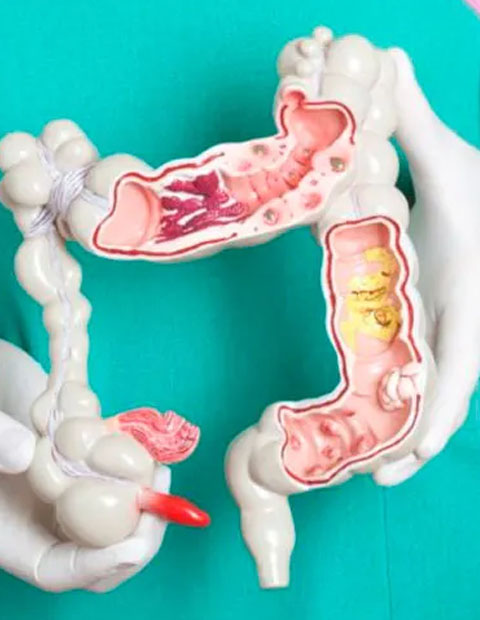What is colorectal cancer?
Cancer starts when cells in the body begin to grow out of control. Colorectal cancer is cancer that originates in the colon or rectum. These cancers may also be called colon cancer or rectal (rectal) cancer depending on where they start. Colon cancer and rectal cancer are often grouped together because they have many common features.
Most colorectal cancer begins as a growth on the inner lining of the colon or rectum. These growths are referred to as polyps.
Some types of polyps can turn into cancer over time (usually many years), but not all polyps turn into cancer. The chance that a polyp will become cancerous depends on the type of polyp. The two main types of polyps are:
- Adenomatous polyps (adenomas): These polyps sometimes turn into cancer.
Because of this, adenomas are called precancerous conditions. - Inflammatory polyps and hyperplastic polyps: These polyps are more
common, but are usually not precancerous.

Other factors that can make a polyp more likely to contain cancer or increase a person’s risk of developing colorectal cancer include:
- If a polyp larger than one centimeter is discovered.
- If it is discovered that there are more than two polyps.
- If after the removal of a polyp the presence of dysplasia is discovered, which is another precancerous condition. This implies that there is an area of the polyp or of the lining of the colon or rectum where the cells look abnormal, but do not quite look like true cancer cells.
Other factors that can make a polyp more likely to contain cancer or increase a person’s risk of developing colorectal cancer include:
In order to better understand colorectal cancer, it is important to know how it is made up.
The colon and rectum make up the large intestine, which is part of the digestive system, also referred to as the gastrointestinal system.

Most of the large intestine is made up of the colon, which is a muscular tube about 1.5 m long. The parts of the colon are divided and have different names depending on the direction in which food travels through them, we start with:
Ascending colon: It begins with a bag called the cecum, where undigested food from the small intestine arrives. It extends up the right side of the abdomen.
Transverse colon: Extends through the body from the right side to the left side.
Descending colon: as it descends (heads down) on the left side.
Sigmoid colon: due to its «S» shape. The sigmoid colon joins the rectum, which connects to the anus.
The ascending and transverse parts of the colon together are referred to as the proximal colon.
While the descending and sigmoid sections of the colon together are referred to as the distal colon.
Colorectal cancer in Mexico
In Mexico, colorectal cancer (CRC) is a disease that seriously affects the population; This condition occupies the third place in incidence, but the first place in mortality among cancers, above prostate and breast cancer.
According to the International Agency for Research on Cancer, belonging to the World Health Organization (WHO), of the 14,900 cases registered in 2018, approximately 48% of diagnosed patients died.
In 2017, there were 85,201 deaths from colorectal cancer in Mexico, with an estimated global rate of 6,506 cases per 100,000 (5.24%), 10.7% in men and 5.5% in women.
The states with the highest death rate were Mexico City (7.24%), Nuevo León (6.71%), Baja California (6.26%), Baja California Sur (6.2%) and Chihuahua (6.2%). The mortality rate per 105 inhabitants and age group has increased in recent years; in 2017 in people 49 years of age or younger it was 1.06% and in people 50 years or older, 22.03%.- Colorectal cancer in Latin America.
It is estimated that worldwide more than one million people per year are diagnosed with this pathology and around 608,000 die from it. In Latin America it ranks fourth among the most frequently diagnosed cancers among men and third among women. Despite this, it still does not seem to receive enough attention.
It is predicted that the increase in its incidence rate in Latin America will not cease, mainly due to people’s standard of living (a more sedentary lifestyle and unhealthy eating habits). The aging of the population will also play a role in increasing incidence rates, estimating that more than 100 million people over the age of 60 will be alive in Latin America and the Caribbean by the year 2020, which will favor the appearance of more cases.
Many factors stand in the way of early diagnosis and timely treatment of colorectal cancer in Latin America, including the relative lack of specialists and the still insufficient infrastructure of the health system. The current infrastructure, in many areas of Latin America, often lacks the capacity to offer screening, chemotherapy and surgery to all patients in a timely manner. - Colorectal cancer worldwide.
Colorectal cancer is a cosmopolitan pathology, with an annual incidence of approximately 1,000,000 cases and a mortality of more than 500,000.
The highest colorectal cancer incidence rates are found in the United States, Western European countries, Australia, and New Zealand; on average there are 45 cases per 100,000 inhabitants, while in Asia and Africa the annual rate is 10 cases per 100,000 inhabitants. Worldwide it is the fourth most common type of cancer.
Screening guidelines are the use of a simple test in a healthy population, to identify those individuals who have a pathology, but do not yet present symptoms. Since colorectal cancer can be detected at an early stage, since it originates from non-malignant precursor lesions, it can be identified through population-based screening programs. Although screening guidelines for colorectal cancer vary in each country, the general recommendation is to start screening in the medium-risk population, starting at age 50 and continuing at regular intervals up to age 75. Screening tests available for colorectal cancer include fecal occult blood test, sigmoidoscopy, and colonoscopy. - Symptoms
They usually appear in advanced stages, so it is very important to keep an eye out for them.
Changes in bowel movements for several days.
Diarrhea that comes and goes.
Constipation.
Thinner stools.
Rectal bleeding, dark stools, blood in stool or on toilet paper.
Cramps or abdominal pain.
Weakness and tiredness.
Persistent feeling of needing to have a bowel movement that does not go away after doing so.
Unexplained weight loss.
If you have any of these symptoms constantly or for a long time (months), do not self-medicate and visit your doctor to find out the cause and treatment. - Treatment for colorectal cancer.
Surgery : An operation in which doctors cut out the cancerous tissue.
Chemotherapy : Special drugs are used to shrink or kill cancer cells. These drugs can be pills you take or drugs injected into your veins, or sometimes both.
Radiation therapy : High-energy rays (similar to X-rays) are used to kill cancer cells.
Immunotherapy: Medicines are used to help a person’s immune system recognize and kill cancer cells more effectively.

